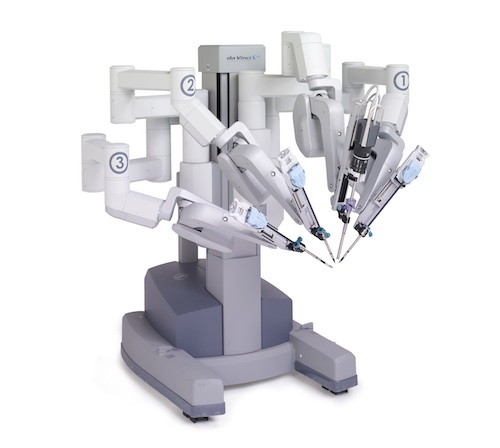 Students will have an opportunity to test drive the da Vinci Surgical System, which enables surgeons’ hand movements to be scaled, filtered and translated into precise movements of the robotic instruments working inside the patient's body.AUSTIN, Texas—On April 24, students, faculty and staff in the College of Natural Sciences will have the chance to test drive the da Vinci Robotic Surgical System, which uses robotic and 3-D visualization technology to enable surgeons' hand movements to be scaled, filtered and translated into precise movements of the robotic instruments working inside the patient's body.
Students will have an opportunity to test drive the da Vinci Surgical System, which enables surgeons’ hand movements to be scaled, filtered and translated into precise movements of the robotic instruments working inside the patient's body.AUSTIN, Texas—On April 24, students, faculty and staff in the College of Natural Sciences will have the chance to test drive the da Vinci Robotic Surgical System, which uses robotic and 3-D visualization technology to enable surgeons' hand movements to be scaled, filtered and translated into precise movements of the robotic instruments working inside the patient's body.
A panel of surgeons will discuss how robotic surgery is being used right now, and how it’s likely to impact the future of surgery.
“The goal of the event is to expose students, particularly pre-med students, to where medicine and medical technology are headed,” says Dr. Reginald Baptiste, the college’s Associate Dean of Health Professions. “This is the future. Students need to see it.”
Baptiste, a cardiothoracic surgeon, says that in many respects the discipline of surgery has reached the limits of what it can accomplish relying solely on surgeons’ hands and the instruments they can hold in them.
“This is about taking surgery to the next level,” he says. “It’s a leap in terms of our ability to visualize areas in parts of the bodies that formerly were difficult to see. It’s also a leap forward in terms of our ability to be precise and dextrous in these very tight spaces.”
Robotic surgical systems, like the da Vinci system, are currently used primarily to perform gynecological and urological surgeries. As the technology improves, however, and as more surgeons become trained in it, Baptiste and his colleagues believe that that the uses will extend into more types of surgery in more regions of the body.
“Learning the techniques of robotic surgery is actually much quicker and easier than learning traditional laporascopic surgery,” says Dr. Thomas Payne, the medical director of the Texas Institute for Robotic Surgery, which is co-sponsoring the event. “I have no doubt that robotic surgery will be a part of the practice of nearly every current undergraduate who successfully navigates med school and becomes a surgeons.”
The event is being held in the lobby of the Biomedical Engineering Building, at the corner of University and Dean Keeton St.
From 2-5 p.m. students will be able test drive The da Vinci Surgical Robot and experience the 3D HD Skills Simulator.
From 6-8 p.m. surgeons will discuss the da Vinci System and the coming convergence of surgery and bioengineering, during which there will be refreshments and additional time to experience the da Vinci Robot & Simulator.
Contact: Daniel Oppenheimer, (512) 745-3353, oppenheimer@austin.utexas.edu


















Comments 1
I agree with Dr. Payne, these robotic advances are just part of the overall technology evolution in the world today. With time, robotic surgery will become more commonplace, become less inexpensive, and eventually become a norm in how surgery is performed.